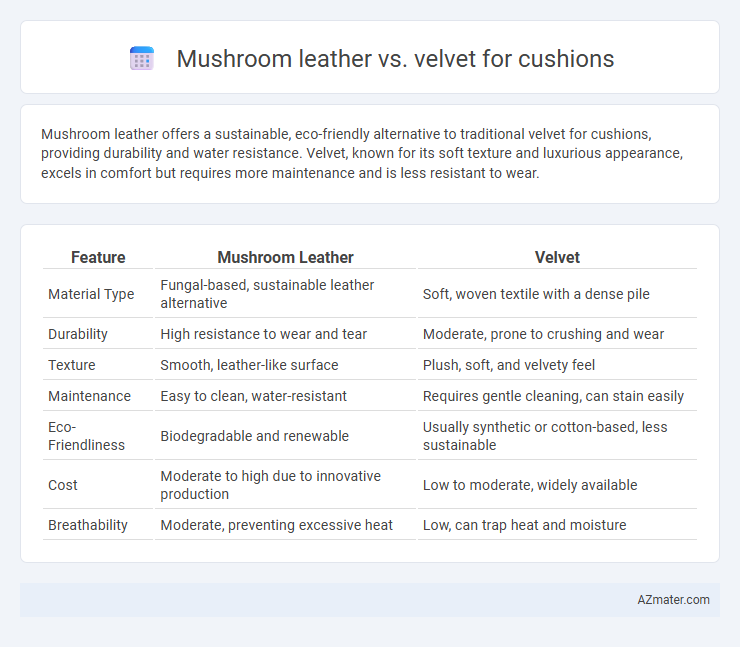Mushroom leather offers a sustainable, eco-friendly alternative to traditional velvet for cushions, providing durability and water resistance. Velvet, known for its soft texture and luxurious appearance, excels in comfort but requires more maintenance and is less resistant to wear.
Table of Comparison
| Feature | Mushroom Leather | Velvet |
|---|---|---|
| Material Type | Fungal-based, sustainable leather alternative | Soft, woven textile with a dense pile |
| Durability | High resistance to wear and tear | Moderate, prone to crushing and wear |
| Texture | Smooth, leather-like surface | Plush, soft, and velvety feel |
| Maintenance | Easy to clean, water-resistant | Requires gentle cleaning, can stain easily |
| Eco-Friendliness | Biodegradable and renewable | Usually synthetic or cotton-based, less sustainable |
| Cost | Moderate to high due to innovative production | Low to moderate, widely available |
| Breathability | Moderate, preventing excessive heat | Low, can trap heat and moisture |
Introduction to Mushroom Leather and Velvet
Mushroom leather, crafted from mycelium, offers a sustainable and biodegradable alternative to traditional materials, combining durability with a soft, supple texture ideal for cushions. Velvet, a classic textile made from woven silk, cotton, or synthetic fibers, provides a rich, plush surface known for its luxurious feel and vibrant color retention on cushions. Both materials excel in comfort and aesthetic appeal but differ significantly in environmental impact and maintenance requirements.
Material Composition and Origins
Mushroom leather, derived from mycelium--the root structure of fungi--is an eco-friendly, biodegradable material with a natural, textured finish, offering a sustainable alternative to traditional upholstery. Velvet, historically made from silk or cotton and now often produced with synthetic fibers, features a plush, soft pile that provides a luxurious feel but relies on resource-intensive cultivation or chemical processing. The organic origins of mushroom leather contribute to its growing popularity in eco-conscious interior design, while velvet remains prized for its rich texture and vibrant colors.
Sustainability and Environmental Impact
Mushroom leather, crafted from mycelium, offers a biodegradable and renewable alternative to conventional materials, significantly reducing carbon footprint and waste compared to velvet made from synthetic fibers. Velvet production often involves intensive resource use and chemical treatments, contributing to environmental pollution and non-biodegradable waste. Choosing mushroom leather cushions supports sustainable interior design by minimizing ecological impact and promoting the use of innovative, eco-friendly materials.
Comfort and Texture Comparison
Mushroom leather offers a smooth, supple texture with a slight natural grain, providing a unique blend of durability and comfort that adapts to body heat for enhanced coziness. Velvet boasts a plush, dense pile with a soft, luxurious feel that excels in warmth and tactile richness, ideal for creating inviting cushions. While mushroom leather delivers a modern, eco-friendly alternative with breathability and resilience, velvet prioritizes softness and visual depth, making comfort preferences dependent on touch sensitivity and aesthetic requirements.
Durability and Longevity
Mushroom leather offers superior durability and resistance to wear compared to velvet, making it ideal for cushions subjected to frequent use and pressure. Velvet, while luxurious and soft, tends to wear down faster, showing signs of pilling and fabric thinning over time. The natural resilience of mushroom leather ensures longer-lasting cushions with minimal maintenance, enhancing both sustainability and performance.
Maintenance and Cleaning Requirements
Mushroom leather offers superior durability and is highly resistant to stains, requiring only a damp cloth for regular cleaning and occasional use of mild soap for tougher spots. Velvet cushions demand more careful maintenance, needing gentle vacuuming to remove dust and delicate spot cleaning with specialized fabric cleaners to prevent crushing or discoloration. Choosing mushroom leather reduces long-term upkeep, whereas velvet requires consistent, gentle care to preserve its texture and appearance.
Aesthetic Appeal and Design Versatility
Mushroom leather offers a unique, sustainable aesthetic with a smooth, matte finish that enhances modern and eco-friendly interior designs. Velvet boasts a rich, plush texture and vivid color depth, making it ideal for creating luxurious, classic, or eclectic cushion styles. Both materials provide distinct design versatility, with mushroom leather's natural tones complementing minimalist decor and velvet's wide color palette adding warmth and visual interest.
Cost and Availability
Mushroom leather, derived from sustainable mycelium, often comes at a higher price point due to its innovative production process and limited availability in the market. Velvet cushion covers tend to be more affordable and widely accessible, thanks to established manufacturing and distribution channels. Consumers seeking eco-friendly options may face higher costs and less availability with mushroom leather compared to the traditional and budget-friendly velvet.
Health and Allergy Considerations
Mushroom leather, made from mycelium, is hypoallergenic and naturally antimicrobial, reducing risks of allergic reactions and improving indoor air quality for cushion users. Velvet, typically made from synthetic fibers or animal silk, may trap dust mites and allergens, potentially aggravating respiratory conditions or skin sensitivities. Choosing mushroom leather cushions supports a healthier environment through breathability and resistance to common allergens, ideal for allergy-prone individuals.
Final Verdict: Which Is Best for Cushions?
Mushroom leather offers sustainability and durability with a unique texture that resists stains and wear, making it ideal for long-lasting cushions. Velvet provides a plush, luxurious feel and vibrant color options but requires more maintenance and is prone to crushing and staining. Choosing between mushroom leather and velvet depends on whether durability and eco-friendliness or softness and aesthetics are the priority for your cushions.

Infographic: Mushroom leather vs Velvet for Cushion
 azmater.com
azmater.com